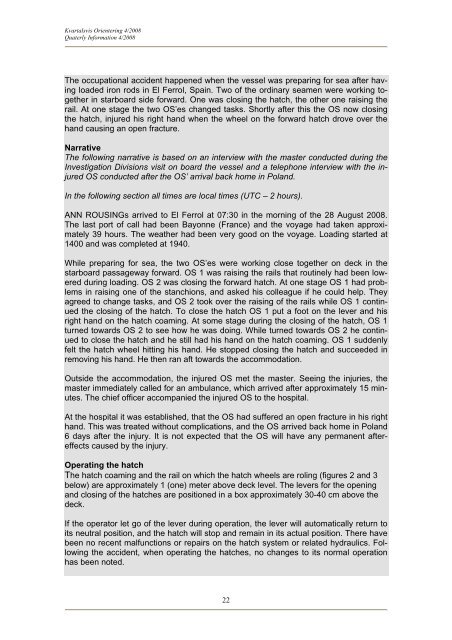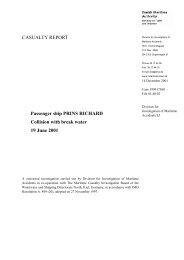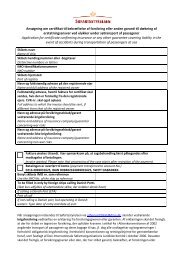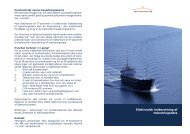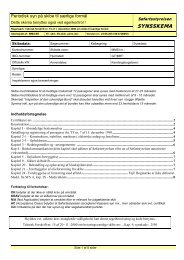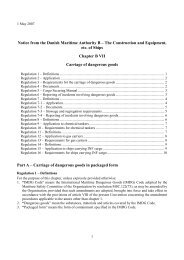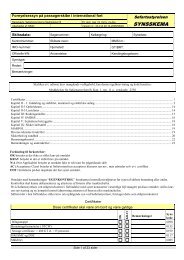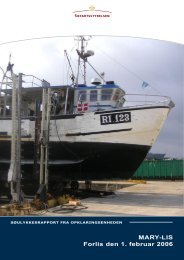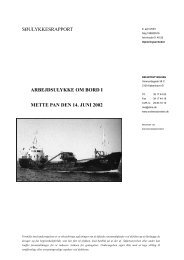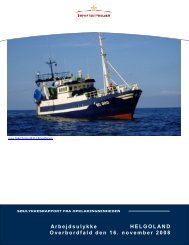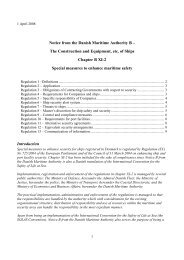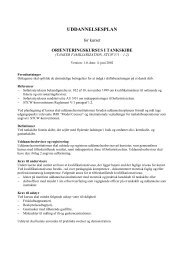Kvartalsvis Orientering 4/2008 - Søfartsstyrelsen
Kvartalsvis Orientering 4/2008 - Søfartsstyrelsen
Kvartalsvis Orientering 4/2008 - Søfartsstyrelsen
Create successful ePaper yourself
Turn your PDF publications into a flip-book with our unique Google optimized e-Paper software.
<strong>Kvartalsvis</strong> <strong>Orientering</strong> 4/<strong>2008</strong><br />
Quaterly Information 4/<strong>2008</strong><br />
The occupational accident happened when the vessel was preparing for sea after having<br />
loaded iron rods in El Ferrol, Spain. Two of the ordinary seamen were working together<br />
in starboard side forward. One was closing the hatch, the other one raising the<br />
rail. At one stage the two OS’es changed tasks. Shortly after this the OS now closing<br />
the hatch, injured his right hand when the wheel on the forward hatch drove over the<br />
hand causing an open fracture.<br />
Narrative<br />
The following narrative is based on an interview with the master conducted during the<br />
Investigation Divisions visit on board the vessel and a telephone interview with the injured<br />
OS conducted after the OS’ arrival back home in Poland.<br />
In the following section all times are local times (UTC – 2 hours).<br />
ANN ROUSINGs arrived to El Ferrol at 07:30 in the morning of the 28 August <strong>2008</strong>.<br />
The last port of call had been Bayonne (France) and the voyage had taken approximately<br />
39 hours. The weather had been very good on the voyage. Loading started at<br />
1400 and was completed at 1940.<br />
While preparing for sea, the two OS’es were working close together on deck in the<br />
starboard passageway forward. OS 1 was raising the rails that routinely had been lowered<br />
during loading. OS 2 was closing the forward hatch. At one stage OS 1 had problems<br />
in raising one of the stanchions, and asked his colleague if he could help. They<br />
agreed to change tasks, and OS 2 took over the raising of the rails while OS 1 continued<br />
the closing of the hatch. To close the hatch OS 1 put a foot on the lever and his<br />
right hand on the hatch coaming. At some stage during the closing of the hatch, OS 1<br />
turned towards OS 2 to see how he was doing. While turned towards OS 2 he continued<br />
to close the hatch and he still had his hand on the hatch coaming. OS 1 suddenly<br />
felt the hatch wheel hitting his hand. He stopped closing the hatch and succeeded in<br />
removing his hand. He then ran aft towards the accommodation.<br />
Outside the accommodation, the injured OS met the master. Seeing the injuries, the<br />
master immediately called for an ambulance, which arrived after approximately 15 minutes.<br />
The chief officer accompanied the injured OS to the hospital.<br />
At the hospital it was established, that the OS had suffered an open fracture in his right<br />
hand. This was treated without complications, and the OS arrived back home in Poland<br />
6 days after the injury. It is not expected that the OS will have any permanent aftereffects<br />
caused by the injury.<br />
Operating the hatch<br />
The hatch coaming and the rail on which the hatch wheels are roling (figures 2 and 3<br />
below) are approximately 1 (one) meter above deck level. The levers for the opening<br />
and closing of the hatches are positioned in a box approximately 30-40 cm above the<br />
deck.<br />
If the operator let go of the lever during operation, the lever will automatically return to<br />
its neutral position, and the hatch will stop and remain in its actual position. There have<br />
been no recent malfunctions or repairs on the hatch system or related hydraulics. Following<br />
the accident, when operating the hatches, no changes to its normal operation<br />
has been noted.<br />
22


